Snarky
Billiard ball example
The billiard ball example is simply using billiard balls as timing devices, each starting at rest and then accelerating at free fall when triggered, like a relay race. Billiard balls are not interacting in this example; they are just timing devices. It is interesting to note that one billiard ball dropped from the top of the building takes about 10 seconds to hit the ground at free fall. Additional billiard balls are introduced to incorporate a resistance or hauling effect in the progression. Different arrangements of billiard balls are used to show different scenarios. The example serves to illustrate that the overall collapse (assuming it is possible) should have taken longer than 10 seconds. The example should not be confused with attempting to calculate an actual collapse time.
Elastic collisions
The graph you have produced illustrates perfect elastic collisions and looks correct to me.
What does Judy Wood say here?
I can see how Dr Wood's notes are confusing. Some more diagrams would have been helpful! She seems to be contradicting herself here. In the context of elastic collisions, Block-A transfers momentum to Block-B. Isn't this "transfer" synonymous with "triggering the next sequence"? What does she mean Block-A will not arrive in time to transfer momentum - hasn't that already happened? It's not very clear, but I think she means that momentum will not increase in the sense that it won't increase beyond free fall speed. That's the only interpretation I can think of. Your explanation and graph makes more sense to me.
Inelastic collisions
Inelastic collisions are probably a more realistic model. Judy Wood explains this type of collision with the equation demonstrating that when two bodies of equal mass impact and "stick" together they will continue to travel at half their original speed, i.e. conservation of momentum. That link you provided (HERE) includes the correct governing equations to model the collapse, which when plotted look like this.
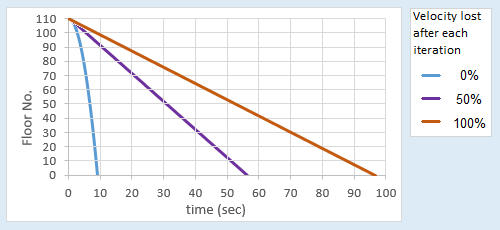
So using this model of collapse, the overall collapse time should be somewhere between 10 and 100 seconds.
Reality check
Judy Wood does not claim that the collapse should have taken 100 seconds. Rather, she argues that the progressive collapse or "pancake" model is fundamentally wrong.
*
--------------------------------------------------------------------------------------
NickyNyce
The first link you posted on 5 June entitled "Debunking the 9/11 Myths" does not have anything to do with Judy Wood's work. I can't see the relevance of this article. I see it as a bunch of claims that are arguably 'easy targets' and attempts to debunk them. It does not attempt to address these points:
1. The buildings fell too quickly
2. A larger debris pile should have resulted (not predominantly dust size)
3. A larger seismic signal should have been recorded
I want to focus on the above three points because:
A) they are relevant to this thread about Judy Wood and what she talks about
B) they are not 'easy targets' to debunk as some would imagine
I have watched your videos and noted the following:
Video 1
9/11: Ground Zero's Responders (2012)
- dust
- paper
- ground rumbling prior to collapse
- building 7 quiet when it came down
- spontaneous fires
- boots 'melting' and "needed replacing every two days"
Video 2
WTC Underground Images @ 100ft
- voids / space below ground big enough for people to enter implies it did not all cave in
- "the deeper they went, the more preserved everything was"
- 100 feet down* the floors were virtually untouched
- a lot of the cars were in pristine condition and were driven out
- remains of many victims not found
* Note the WTC basement extended to bedrock that is 70 feet below ground, not 100 feet..
Debris obviously penetrated in some areas and Judy Wood is not denying this.
These videos paint a clearer picture of what happened at Ground Zero.
9/11 Debris: Investigation of Ground Zero, Pt. 1
9/11 Debris: Investigation of Ground Zero, Pt. 2
--------------------------------------------------------------------------------------
DEBRIS PILE
Can anyone tell me what's wrong with this picture?
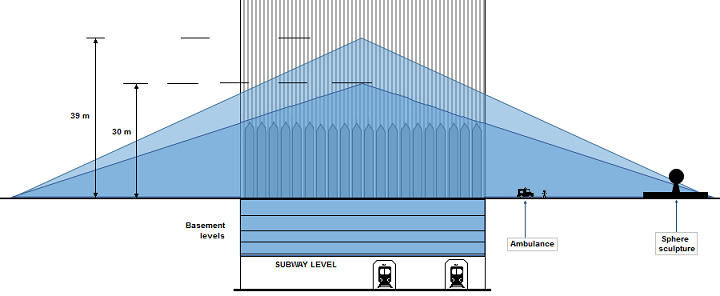
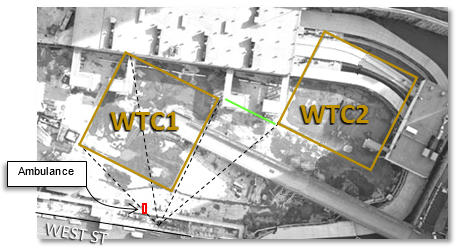
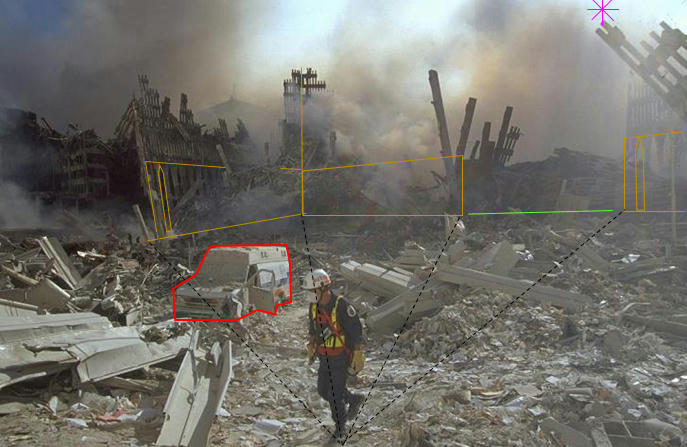
Billiard ball example
The billiard ball example is simply using billiard balls as timing devices, each starting at rest and then accelerating at free fall when triggered, like a relay race. Billiard balls are not interacting in this example; they are just timing devices. It is interesting to note that one billiard ball dropped from the top of the building takes about 10 seconds to hit the ground at free fall. Additional billiard balls are introduced to incorporate a resistance or hauling effect in the progression. Different arrangements of billiard balls are used to show different scenarios. The example serves to illustrate that the overall collapse (assuming it is possible) should have taken longer than 10 seconds. The example should not be confused with attempting to calculate an actual collapse time.
Elastic collisions
The graph you have produced illustrates perfect elastic collisions and looks correct to me.
What does Judy Wood say here?
QuoteIf Block-A stops moving, after triggering the next sequence, the mass of Block-A will not arrive in time to transfer momentum to the next "pancaking" between Block-B and Block-C. In other words, the momentum will not be increased as the "collapse" progresses.
I can see how Dr Wood's notes are confusing. Some more diagrams would have been helpful! She seems to be contradicting herself here. In the context of elastic collisions, Block-A transfers momentum to Block-B. Isn't this "transfer" synonymous with "triggering the next sequence"? What does she mean Block-A will not arrive in time to transfer momentum - hasn't that already happened? It's not very clear, but I think she means that momentum will not increase in the sense that it won't increase beyond free fall speed. That's the only interpretation I can think of. Your explanation and graph makes more sense to me.
Inelastic collisions
Inelastic collisions are probably a more realistic model. Judy Wood explains this type of collision with the equation demonstrating that when two bodies of equal mass impact and "stick" together they will continue to travel at half their original speed, i.e. conservation of momentum. That link you provided (HERE) includes the correct governing equations to model the collapse, which when plotted look like this.

So using this model of collapse, the overall collapse time should be somewhere between 10 and 100 seconds.
Reality check
Judy Wood does not claim that the collapse should have taken 100 seconds. Rather, she argues that the progressive collapse or "pancake" model is fundamentally wrong.
QuoteAccording to the pancake theory, one floor fails and falls onto the floor below, causing it to fail and fall on the floor below that one, and so forth. The "pancake theory" implies that this continues all the way to the ground floor. In the case of both WTC towers, we didn't see the floors piled up when the event was all over, but rather a pulverization of the floors throughout the event. So, clearly we cannot assume that the floors stacked up like pancakes. Looking at the data, we take the conservative approach that a falling floor initiates the fall of the one below, while itself becoming pulverized. In other words, when one floor impacts another, the small amount of kinetic energy from the falling floor is consumed (a) by pulverizing the floor and (b) by breaking free the next floor. In reality, there isn't enough kinetic energy to do either.*
*
Spoiler
Wood references:
Trumpman
Paper: http://911research.wtc7.net/papers/trumpman/CoreAnalysisFinal.htm
Hoffman
Paper: http://911research.wtc7.net/papers/dustvolume/index.html
YouTube vid: https://www.youtube.com/watch?v=UKG2nWlQM80
Note: If you don't like Wood's presentation style, you may prefer Hoffman.
Trumpman
Paper: http://911research.wtc7.net/papers/trumpman/CoreAnalysisFinal.htm
Hoffman
Paper: http://911research.wtc7.net/papers/dustvolume/index.html
YouTube vid: https://www.youtube.com/watch?v=UKG2nWlQM80
Note: If you don't like Wood's presentation style, you may prefer Hoffman.
[close]
--------------------------------------------------------------------------------------
NickyNyce
The first link you posted on 5 June entitled "Debunking the 9/11 Myths" does not have anything to do with Judy Wood's work. I can't see the relevance of this article. I see it as a bunch of claims that are arguably 'easy targets' and attempts to debunk them. It does not attempt to address these points:
1. The buildings fell too quickly
2. A larger debris pile should have resulted (not predominantly dust size)
3. A larger seismic signal should have been recorded
I want to focus on the above three points because:
A) they are relevant to this thread about Judy Wood and what she talks about
B) they are not 'easy targets' to debunk as some would imagine
I have watched your videos and noted the following:
Video 1
9/11: Ground Zero's Responders (2012)
- dust
- paper
- ground rumbling prior to collapse
- building 7 quiet when it came down
- spontaneous fires
- boots 'melting' and "needed replacing every two days"
Video 2
WTC Underground Images @ 100ft
- voids / space below ground big enough for people to enter implies it did not all cave in
- "the deeper they went, the more preserved everything was"
- 100 feet down* the floors were virtually untouched
- a lot of the cars were in pristine condition and were driven out
- remains of many victims not found
* Note the WTC basement extended to bedrock that is 70 feet below ground, not 100 feet..
Debris obviously penetrated in some areas and Judy Wood is not denying this.
These videos paint a clearer picture of what happened at Ground Zero.
9/11 Debris: Investigation of Ground Zero, Pt. 1
9/11 Debris: Investigation of Ground Zero, Pt. 2
--------------------------------------------------------------------------------------
DEBRIS PILE
Can anyone tell me what's wrong with this picture?





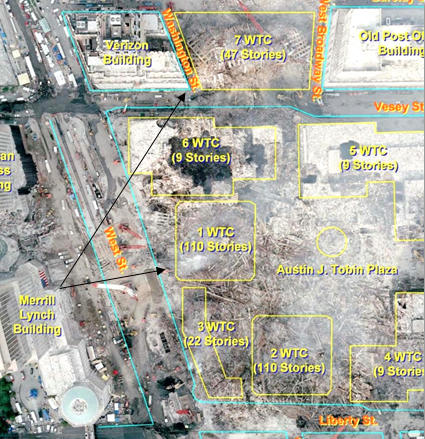
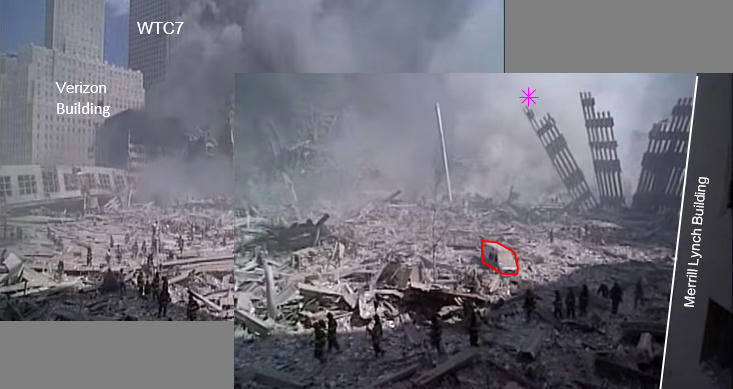
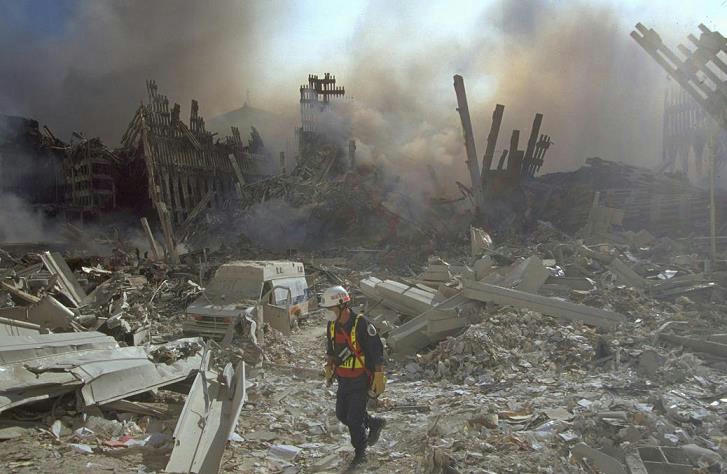
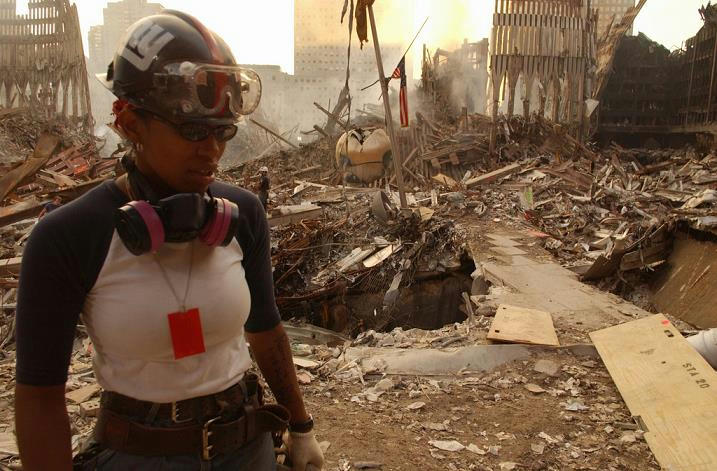
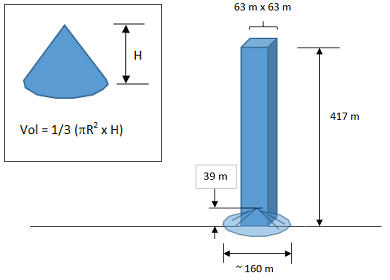
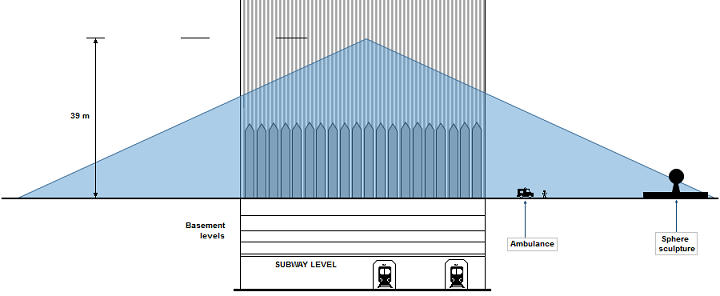
 You responded to the one thing that didn't relly warrant a response! Please read all that other stuff I talk about, and then respond to something that actully deserves a response.
You responded to the one thing that didn't relly warrant a response! Please read all that other stuff I talk about, and then respond to something that actully deserves a response.


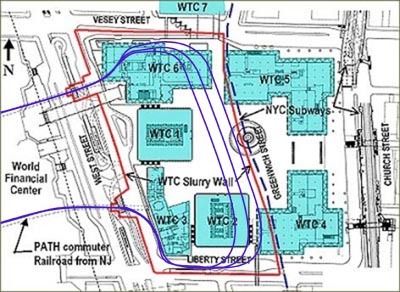

 English was not my best subject. All I'm trying to say is that ALL of the evidence needs to be looked at and explained.
English was not my best subject. All I'm trying to say is that ALL of the evidence needs to be looked at and explained.